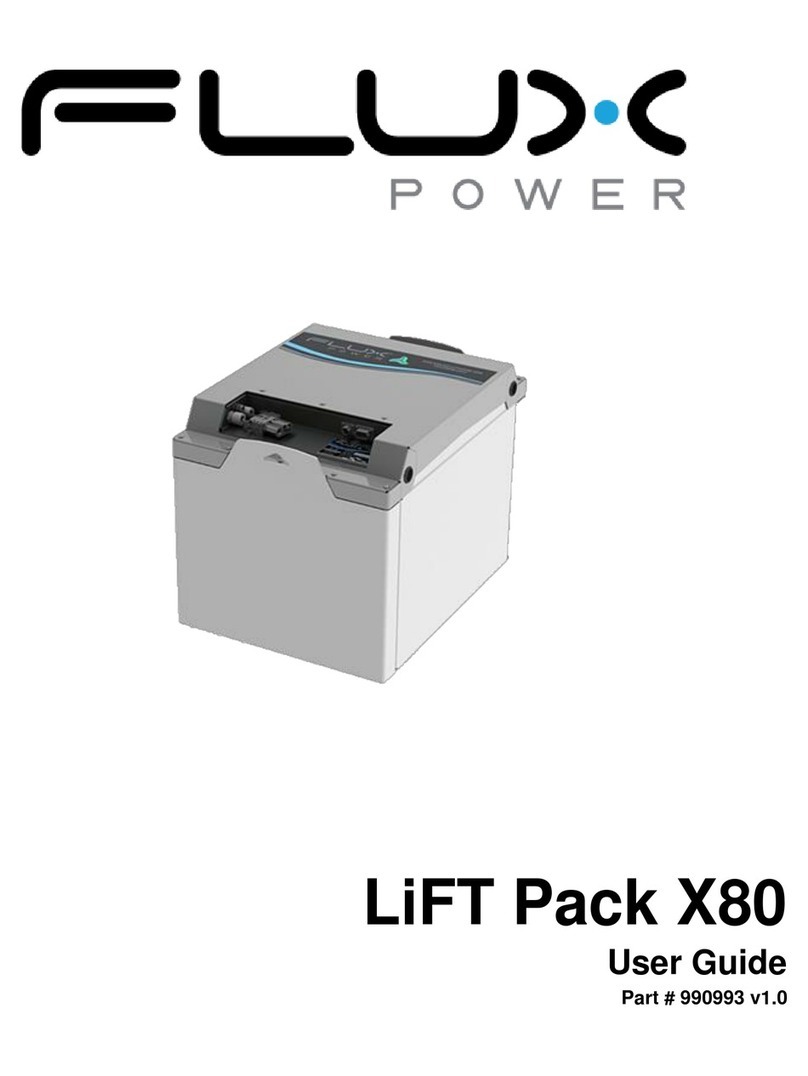FLUX POWER LiFT Pack Instruction Manual

Contents
LiFTPACK™BATTERYCONSTRUCTION...............................................................2
TEMPERATUREPERFORMANCE..........................................................................3
CHARGER/CHARGING.......................................................................................3
CELLCHEMISTRYANDCONSTRUCTION..............................................................5
SHIPPING&RECYCLING......................................................................................6
SAFETY................................................................................................................7
MISCELLANEOUS................................................................................................8
FREQUENTLY
ASKED
QUESTIONS
LiFTPack™AdvancedLithiumBattery

2FAQ
FA
Q
LiFTPACK™BATTERYCONSTRUCTION
WhatistheFluxLiFTPackBatterymadefrom?
TheLiFT‐24Vpackisbuiltfromeitherlargeformatprismaticor
pouchlithium‐ioncells.Thecellsareconstrainedagainstshockand
vibrationina10gaugeA36steelenclosure.Battery
interconnectionsaremadewithflexiblebusbarsandAWG2high
strandcabling.Theschematictotherightillustratesallofthe
integralpartsofaLiFTPack.
WhatdoestheLEDpaneltellme?
1) WhentheLightsarestatictheLEDactsasabatterydischargeindicator(BDI).
2) IfthereisasingleflashinglightitisaDeviceTroubleCode(DTC).
3) Ifthelightsarelightinginseriesitconfirmsthepackischarging.
IsthereaBatteryDischargeIndicator(BDI)onthepack?
Yes,thereisaBDIorStateofCharge(SOC)indicatoronthepack.AseriesofLEDsindicatethebatteriesstateofchargefrom
0‐100%.Whenthepackisat5%theredLEDwillbelitasindicatedbelow,inadditionabuzzerwillsoundindicatingthepack
shouldbepluggedinforcharging.Tomaintainbatteryperformancewestronglyrecommendthepackbepluggedinatthis
point.
WhatAreDeviceTroubleCodes(DTC)?
Ifthepackisoperatingoutsideofoperationalparameters,theBMSwillcutpowertothe
pack,andblinkasinglespecificLEDrelatedtoaDTC.Thediagramtotherightdetailsthe
DTCsassociatedwitheachlight.

3FAQ
FA
Q
TEMPERATUREPERFORMANCE
Whataretheeffectsoftemperatureoncapacityandoperationforbothhigh(120‐
140˚F)andlowtemperatures(0‐20˚F)?
Thesupporteddischargetemperaturerangeis‐4˚Fto140˚Fandsupportedchargerangeis32˚Fto140˚F.At140˚Fthe
availablecapacityis100%,at32˚Fthereis75%availablecapacity,andat‐4˚Fthereis41%availablecapacity.Constant
operationat140˚Fmayreducethebatterycyclelifetimeby10‐20%.
Isthetemperaturerangeof‐20Cto60C(‐4Fto140F)theoperatinginternal
temperatureofthepackortheambienttemperature?
Thisistheinternaloperatingtemperature.Therearetemperaturesensorsinsidethepackwhichmonitortheoperating
temperature.Ifthetemperaturerangeisexceeded,thebuzzerwillsoundandthepackwillautomaticallyshutoffuntilthe
packisallowedtocool/heattowithinoperationalparameters.
WhatisthetemperatureincreaseduringuseofFluxLiFTPackscomparedtoLead‐Acid?
FluxLiFTPacksexperienceminimaltemperatureincreaseduringcharginganddischarging.TestsrunbyFluxPowerindicate
floodedlead‐acidtemperaturesincrease27%moreandAGMincrease47%morethanFluxLiFTpacksduringa1hour
completedischarge.Thisisduetothelowerinternalresistanceoflithium‐ionvs.lead‐acid,andmeansthebatterywastes
lessenergywhencharginganddischarging.
CHARGER/CHARGING
CanFluxLiFTPacks
TM
beopportunitycharged?
Yes,FluxLiFTPackscanbepluggedinatanystateofchargewithabsolutelynonegativeeffects.Infact,opportunitycharging
canactuallyincreasethelifetimeamp‐houroutputofthebattery.Thepackdoesneedperiodicbalancinghowever,andwe
recommendleavingitpluggedinovernightorovertheweekendonceeveryweekortwo.
Whathappenswhenthepackrunsoutofcharge?
Whenthebatteryreaches5%SOCabeeperwillsoundnotifyingtheoperatorthatthebatterymustbecharged.Oncethe
batteryreaches1%SOCthebeeperwillsoundagain,notifyingtheoperatoragain.Finallyitwillcutpowerintermittentlyand
allowthepalletjacktobeslowlydriventoachargingpoint.Werecommendpluggingthepackinassoonastheinitialbuzzer
soundstoprolongthelifeofthebattery.Ifthepackisnotpluggedinandleftsittinginanunchargedstate,itispossiblethe
lithiumcellswillbepermanentlydamagedandnolongerfunction.
DoIneedtodisconnecttheLiFTPackfromthewalkie/palletjacktochargeit?
IftheLiFTPackhasaninternalchargeritdoesnotneedtobedisconnectedfromthewalkietochargeit.However,pleasebe
awarethatthepalletjackwillbeoperationalwhilechargingsoit’srecommendedtheAndersonpowerconnectorbe
disconnected.

4FAQ
FA
Q
Ifthepackispluggedinforcharging,isthewalkie/palletjackoperational?
Yesthewalkieisoperational;unpluggingthemainAndersonpowerconnectorisrecommended.
AtwhattemperaturescanIchargeaFluxLiFTPack?
FluxLiFTPacksshouldonlybechargedbetween32˚F‐140˚F.
IsitOKtoleavetheLiFTPackpluggedin?
Yes,theBatteryManagementSystem(BMS)monitorschargingsothebatterywillneverovercharge.Fluxactually
recommendsleavingthechargerpluggedinatalltimeswhenthebatteryisnotinuse.
Canyouoverchargeoroverdischargethepacks?
FluxPower’spatentedBatteryManagementSystem(BMS)monitorschargingsothatthepackcannotbeoverchargedor
discharged.Theonlypossibleriskisifsomeonefullydischargesthebatterypackandthendoesnotplugitin.Inthiscase,
becauseofthesmallparasiticdrawfromtheelectronics,itispossibletocompletelykillthepack.Thisiswhywerecommend
thepacksremainpluggedinwhenevernotinuseformorethanafewdays.Thereisnoharminleavingthepackspluggedin,
butgreatharmiftheyareleftdischargedforextendedperiodsoftime.
WhattypeofchargerandchargingprofileisusedintheLiFTPack?
TheonboardchargerisahighfrequencyBMScontrolleddevice.Itwillchargeatconstantcurrentuntilthepackvoltage
reaches28.55Vandthenuseafloatvoltageof28.55Vtofinishchargingandbalancing.
Canalead‐acidchargerbeusedtochargetheFluxbattery?
FluxLiFTPacksrequireahigherchargingvoltagethanlead‐acidandcomewithanonboardcharger.Howeverinsome
instancesalead‐acidchargercanbeusedtopartiallychargetheLiFTPack–butforoptimalperformance,alwaysusethe
onboardcharger.
IsthechargerCEC(CaliforniaEnergyCommission)approved/rated?
InternalchargersareexemptfromneedingCECapproval(mobileplatform)andtheexternalchargerisexemptuntilFeb.1
st
2017.
HowmuchcurrentdoestheLiFTPackonboardchargerdraw?
Itisa775Wcharger,sothecurrentdrawisdependentonthesuppliedvoltage.Ifthesocketsupplies130V,thechargerwill
draw5.9A.Ifthewallsocketsupplies110V,thechargerwilldrawapproximately7A.StandardUSelectricaloutletssupplya
rangeofvoltagesdependingonthedistancefromthetransformer.
Whattypeofcordisusedforcharging?
Aregular120VACextensioncordisusedforcharging.TheLiFTPackshipswitha10ftcord.Thechargerrequires105‐130Vto
functionproperly,souseawiresizingguideifyouwishtousealongerextensioncord.

5FAQ
FA
Q
Atwhatdepthofdischarge(DOD)doesthebatteryexperience1cycle?
Thereisnopointatwhichadischargecountsas1cycle.Eachcycleputswearonthebatteryproportionaltoitsdepthof
discharge.Ifthebatteryisdischargedto80%everycycle,itwilllast~2000cycles.Ifthebatteryiscycledat70%DOD,the
batterywilllast~3,000cycles.
Thishasanonlineareffectonthetotalamp‐houroutputofthebatteryoveritslifetime.ThesmallertheDODis,thelarger
thetotalAhoutputofthebatteryis.Comparingthelifetimeoutputoftwo100Ahbatteriesat80%and70%DOD,thetotal
Ahoutputcanbeidealizedbythefollowing:
100Ah*0.8DOD*2000=160,000Ahtotaloutput,
100Ah*0.7DOD*3000=210,000Ahtotaloutput.
Inrealitythetotallifetimeoutputnumberswillbeclosertogether,asfactorssuchasbatteryagingarenotbeingconsidered,
howeverthe70%DODbatterywillstilloutputmoreAhoveritslifetime.Thisisthemainreasonwhyopportunitychargingis
aperfectfitforLiFTPacks.
CELLCHEMISTRYANDCONSTRUCTION
WhattypesofLithium‐ionchemistriesareavailable,andwhydoweuseLiFePO
4
?
Thereareanumberofdifferentchemistriesavailable.FluxusesLiFePO
4
duetoitslongcyclelife,lowcostofownership,
thermalstability,andhighpoweroutput.BelowisachartwhichprovidessomeinformationonalternativeLithium‐ion
chemistries.
SpecificationsLi‐cobalt
LiCoO
2
(LCO)
Li‐manganese
LiMn
2
O
4
(LMO)
Li‐phosphate
LiFePO
4
(LFP)
NMC
1
LiNiMnCoO
2
Voltage3.60V3.80V3.30V3.60/3.70V
Chargelimit4.20V4.20V3.60V4.20V
Cyclelife5005002,0002,000
Operating
temperature
AverageAverageGoodGood
Specificenergy150–190Wh/kg100–135Wh/kg90–120Wh/kg140‐180Wh/kg
Loading1C10C,40Cpulse35Ccontinuous10C
SafetyAverage.AverageVerysafeSaferthanLi‐cobalt.
Thermal.runaway150°C
(302°F)
250°C
(482°F)
270°C
(518°F)
210°C
(410°F)
*BatteryUniversity
Table of contents
Other FLUX POWER Camera Accessories manuals
Popular Camera Accessories manuals by other brands

Trojan
Trojan GC2 48V quick start guide

Calumet
Calumet 7100 Series CK7114 operating instructions

Ropox
Ropox 4Single Series User manual and installation instructions

Cambo
Cambo Wide DS Digital Series Main operating instructions

Samsung
Samsung SHG-120 Specification sheet

Ryobi
Ryobi BPL-1820 Owner's operating manual














